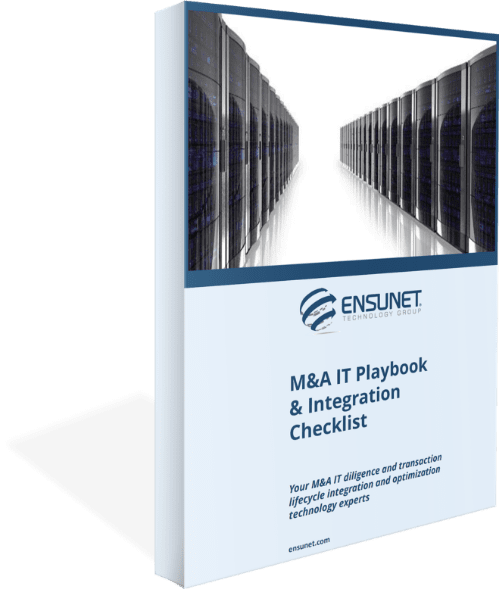M&A IT Playbook & Integration Checklist
Free M&A IT Playbook & Integration Checklist

M&A IT Playbook & Integration Checklist


In all of our previous blogs about IT due-diligence for acquirers, the target companies have all provided familiar goods and services, such as medical devices or supply-chain components for consumer packaged goods.
It’s pretty obvious that an acquirer would need the help of an IT M&A specialist like Ensunet in any of those situations, since IT isn’t a core competence of the company being acquired.
But what if it is?
What if that company you’re looking to acquire makes software? Can you immediately eliminate “IT” from your due-diligence checklist? After all, that’s their business! It’s what they do. What could possibly be missing?
Strengths and weaknesses
Of course you’ve figured it out by now. The very fact that this article didn’t end at the previous paragraph has surely tipped you off to the fact that “IT due diligence is very much required” when you’re scoping out a software company for acquisition. That’s exactly what happened in this story, which we’re going to cloak in anonymity by blurring a few identifying factors.
But this will tell you all you need to know: A prominent New York PE firm was seeking to add a fast-growing software company to its portfolio. This company makes special software that plays an important role in a heavily-regulated industry; they operate in about a dozen different markets globally. They looked like a good acquisition target.
Now, there are differences between “software development” and “enterprise IT.” This company was creating its own products in-house, using its own teams and waterfall development process, which was wholly appropriate for this environment. (That’s because the heavily-regulated industry in which it works moves slowly and methodically. So the company didn’t need the faster, looser “agile” development environment, in case you were curious.)
As it turned out, through our careful due diligence, we discovered that this company was doing a lot of things right, on the software-development side. Its products were stable, well-functioning, and mature. They harnessed mainstream technologies and adhered to standard practices for things like coding and framework, allowing for the addition of new features and functionality. The architecture they employed was scalable. They even had strong policies in place for cybersecurity—always a major concern in M&A.
While we did discover that they were still performing regression testing manually—and thus we recommended an automation tool to change that—we benchmarked them against numerous SaaS (software-as-a-service) competitors, and they fared fairly well.
But even a software company relies on software that it doesn’t create. And here, we found some addressable shortcomings.
A monthly dilemma
Even a company with software-development expertise isn’t going to create its own ERP (enterprise resource planning) system from scratch. So they’ll pick one, off-the-shelf.
Problem is, this company, as a result of its previous organic and inorganic growth, was using three different ERP systems. On the one hand, they had some pretty sophisticated systems. On the other hand, they were still using QuickBooks, and manually entering data into Excel.
“Manual.” As in, “error-prone.”
And “slow.”
As we’d noted in our report to the PE, QuickBooks is a real bottleneck: it has weak controls, limited reporting capability, and caps on its ability to scale. All of which renders it a poor fit for a multi-location, investor-owned entity.
A PE is all about maximizing value. But how can you do that when you can’t trust the numbers in the P&L (profit-and-loss) reporting? That was the case here. The numbers weren’t trustworthy. The systems didn’t talk to each other. Manual entry invited errors.
And boy was this process slow. It would take them three weeks of every month just to perform the monthly financial close. That’s downright embarrassing.
Upgrading to Portfolio Company 2.0
We recommended consolidating all three ERP systems to the most-advanced one. We also recommended a way to automate the monthly close and consolidation process, slashing the turnaround from three weeks to five days, and reducing the error rate to zero. All of these changes will give the PE greater visibility into transactions and annual recurring revenue, while streamlining reporting.
Ensunet has supported IT for billions in pre- and post-merger activity. If you need help with this crucial challenge, download our free M&A IT Playbook & Integration Checklist. Or contact us today for a no-obligation consultation with one of our friendly subject—matter experts.
Reach out to the world’s most reliable IT services.